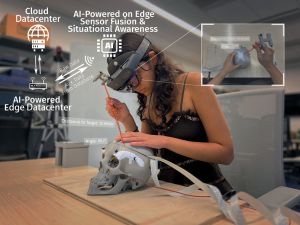The Duke University Intelligent Interactive Internet of Things (I^3T) Lab directed by PI Gorlatova is headquartered in a beautiful sunlit top-floor 650+ sq ft corner space in the newly opened Duke University Wilkinson Engineering Building, in the heart of Duke University campus. Our floor is the hub of the NSF AI Athena Institute for Edge Computing Leveraging Next Generation Networks. The I^3T Lab is adjacent to the labs working on autonomous and embedded systems, robotics, digital health, and applied AI, naturally fostering collaborations and exchange of technical know-how.
Additional up to date information about Duke I3T Lab Facilities is available on the Duke I3T Lab Website.
The I^3T lab is set up for experiments with multiple elements of the Internet of Things, edge computing, augmented reality (AR), and virtual reality.
IoT and edge computing: We have a diverse collection of IoT equipment, including Raspberry Pis, Arduinos, an assortment of low-end motion, video, light, and other sensors, smart lights, and E Ink displays. We have multiple workstations, with NVIDIA GeForce GTX cards, we use as edge servers, and a full range of WiFi devices with different capabilities for experiments with different network and connectivity configurations.
Augmented reality: We work with Microsoft HoloLens and Magic Leap headsets, as well as a wide range of mobile phones that support Google ARCore and Apple ARKit SDKs. We also have multiple stand-alone sensors and measurement setups for experimenting with constituent elements of mobile AR, including depth sensors, wearable eye trackers, and OptiTrack cameras. We work with both Unreal Engine and Unity 3D.
Virtual reality: We work with a range of virtual reality headsets including Oculus Go, Oculus Rift, and Oculus Quest II, and are experienced with Oculus Integration and Google VR SDKs in Unreal Engine and Unity3D. Duke University Electrical and Computer Engineering department has been generously supporting additional space needs that arise in our experiments with room-scale VR.
Directly across the street from us is Duke’s makerspace, Innovation Co-Lab, which offers a full set of equipment for digital modeling and fabrications. We have been making extensive use of its 3D printing capabilities. We are also close to the Shared Materials Instrumentation Facility, which we use for imaging. For computing-intensive machine learning tasks, we often additionally rely on the outstanding resources provided by the Duke Research Computing Cluster.



